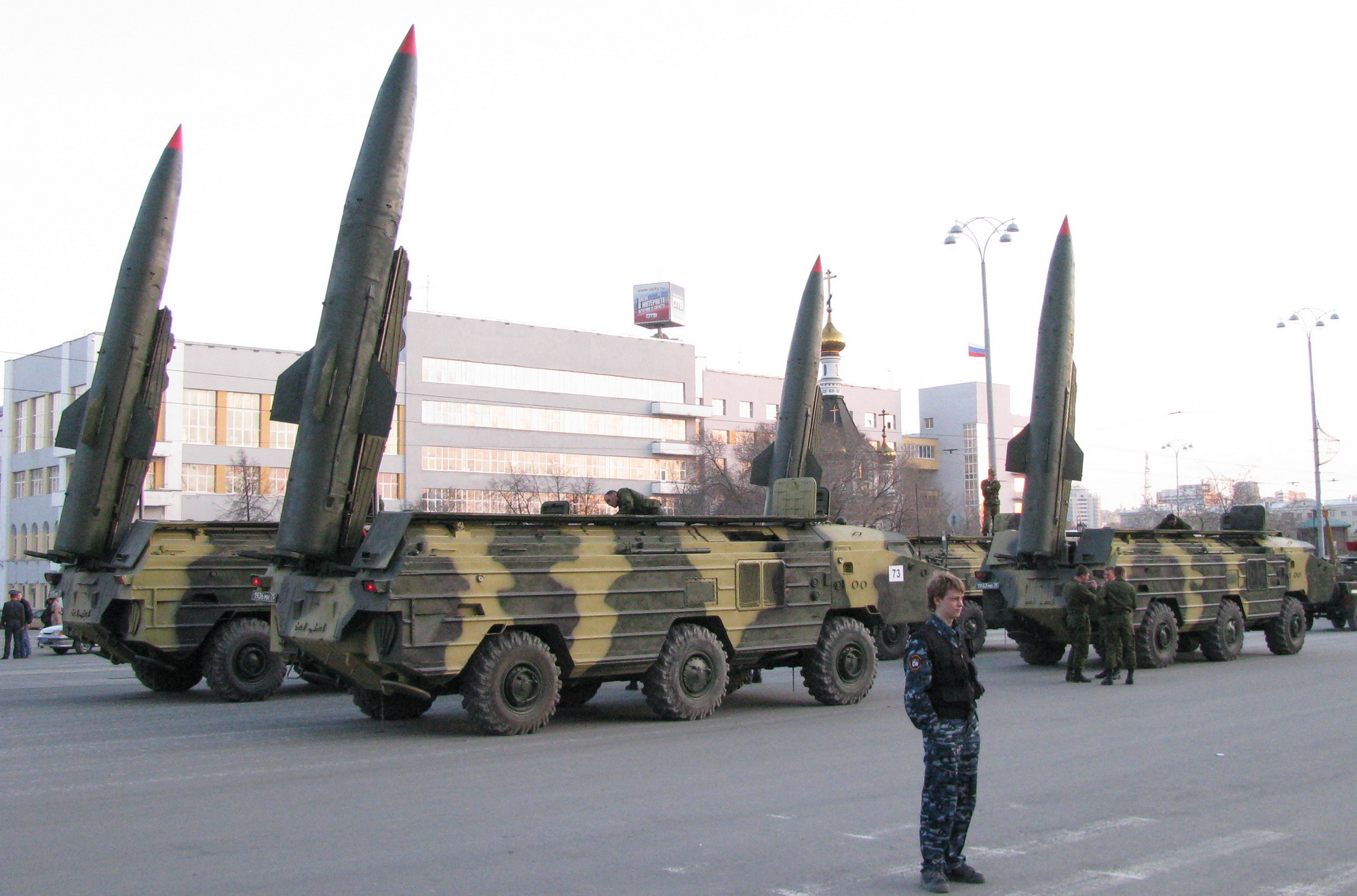How to install the app on iOS
Follow along with the video below to see how to install our site as a web app on your home screen.
Note: This feature may not be available in some browsers.
You are using an out of date browser. It may not display this or other websites correctly.
You should upgrade or use an alternative browser.
You should upgrade or use an alternative browser.
AGMs and Standoff Weapons
- Thread starter Manticore
- Start date
Manticore
RETIRED MOD

- Joined
- Jan 18, 2009
- Messages
- 10,115
- Reaction score
- 114
- Country
- Location
DF-11/CSS-7 (export edition: M-11) short-range tactical ballistic missile:
Propellant: Single-stage solid-fuel
Range: 300 km
Playing length: 9.75 m
Missile diameter: 0.8 m
Projectile Weight: 3.8 tons
Warhead: a 800 kg high-explosive warhead or 9-ton thermonuclear warhead equivalent
Guidance: Inertial gyro + onboard computer;
DF-15 modified with
Accuracy (CEP): 600 meters, 150 meters (modified)

Propellant: Single-stage solid-fuel
Range: 300 km
Playing length: 9.75 m
Missile diameter: 0.8 m
Projectile Weight: 3.8 tons
Warhead: a 800 kg high-explosive warhead or 9-ton thermonuclear warhead equivalent
Guidance: Inertial gyro + onboard computer;
DF-15 modified with
Accuracy (CEP): 600 meters, 150 meters (modified)

Manticore
RETIRED MOD

- Joined
- Jan 18, 2009
- Messages
- 10,115
- Reaction score
- 114
- Country
- Location
Pacrim-ALCM-SLCM


The Raduga 3M-80, 3M-82 and Kh-41 Moskit (SS-N-22 Sunburn) are all variants of the same 4.5 tonne supersonic rocket-ramjet missile. This weapon is the primary armament of the PLA-N's new 956E Sovremennyy class destroyers and is credited with a range between 50 and 120 nautical miles. An air launch centreline tunnel adaptor enables Su-27/30 family strike fighters to carry a single round and this configuration has been displayed on the navalised Su-33. A coastal defence variant labelled the Moskit E is in development, with a two round TEL based on the MZKT-7930 chassis.
Inertial midcourse guidance is supplemented with an Altair active radar seeker - there are no reports to date of land attack derivatives.
Unlike subsonic Western anti-ship missiles such as the Harpoon and Exocet, the Moskit is a supersonic sea-skimmer. It can be programmed to fly a high altitude trajectory at Mach 3, or a sea-skimming trajectory at Mach 2.2. If the sea skimming mode is chosen, the missile will be first detected by a warship under attack when it emerges over the horizon at a distance of about 15 to 25 nautical miles. This provides the defences on the ship with about 25-60 seconds of warning time before impact. The raw speed of the Moskit makes it a challenging target for most shipboard defences.

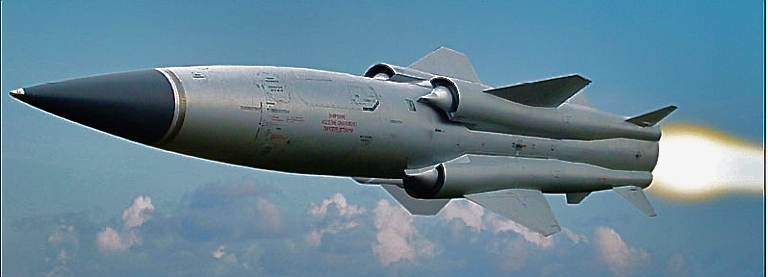
3M80-Sunburn-Cruise-1S
http://www.ausairpower.net/APA-Regional-PGM.html


The Raduga 3M-80, 3M-82 and Kh-41 Moskit (SS-N-22 Sunburn) are all variants of the same 4.5 tonne supersonic rocket-ramjet missile. This weapon is the primary armament of the PLA-N's new 956E Sovremennyy class destroyers and is credited with a range between 50 and 120 nautical miles. An air launch centreline tunnel adaptor enables Su-27/30 family strike fighters to carry a single round and this configuration has been displayed on the navalised Su-33. A coastal defence variant labelled the Moskit E is in development, with a two round TEL based on the MZKT-7930 chassis.
Inertial midcourse guidance is supplemented with an Altair active radar seeker - there are no reports to date of land attack derivatives.
Unlike subsonic Western anti-ship missiles such as the Harpoon and Exocet, the Moskit is a supersonic sea-skimmer. It can be programmed to fly a high altitude trajectory at Mach 3, or a sea-skimming trajectory at Mach 2.2. If the sea skimming mode is chosen, the missile will be first detected by a warship under attack when it emerges over the horizon at a distance of about 15 to 25 nautical miles. This provides the defences on the ship with about 25-60 seconds of warning time before impact. The raw speed of the Moskit makes it a challenging target for most shipboard defences.


3M80-Sunburn-Cruise-1S
http://www.ausairpower.net/APA-Regional-PGM.html
Manticore
RETIRED MOD

- Joined
- Jan 18, 2009
- Messages
- 10,115
- Reaction score
- 114
- Country
- Location
The Novator 3M-54 Club (SS-N-27 Sizzler) comprises a complete family of ship (Club N), submarine (Club S) and air launched weapons. Unlike warship launched Moskit and Yakont variants, the Club is designed for launch from a 533 mm torpedo tube, or a vertical launch tube( Refer Military Parade, 2000-1 Exclusives Issue, Kamnev P., 'The Club Missile System').
Five distinct variants of this weapon exist. The basic 3M-54E1 and 3M-14E most closely resemble the US Navy's anti-ship and land attack Tomahawk missile. This weapon has a range of 160 nautical miles and is subsonic. The 3M-54E1 uses an ARGS-54 active radar seeker and Glonass satellite and inertial guidance, the 3M-14E Glonass satellite and inertial guidance alone. The more advanced 3M-54E combines the subsonic cruise airframe of the 3M-54E1/3M-14E with a Mach 2.9 rocket propelled guided payload.
Like its subsonic sibling, it approaches from under the radar horizon using the same radar seeker to detect its target. Once locked on, it discards the cruise airframe, fires its rocket motor, and accelerates to Mach 2.9 at a sea skimming altitude of 15 feet. Novator claim the missile follows a zig-zag flightpath to defeat defences. Both the 3M-54E1 and 3M-54E are small weapons which are difficult to detect on radar, especially should even basic radar signature reduction techniques be applied to them. The 91RE1 and 91RE2 are rocket boosted homing torpedoes, most closely resembling the US ASROC and Sea Lance weapons. All five weapons in this family share a common launch system and thus any ship, submarine or aircraft equipped for these weapons can carry an arbitrary mix.
Press reports indicate that India has fielded this weapon, and there are claims China also ordered in a 'tit-for-tat' deal for planned Kilo SSKs. The air launched variant has been marketed on the Su-32FN/34 but there are no reports as yet of hard sales.
3M54E1 Sizzler subsonic ASCM (Novator)


3M54E Sizzler supersonic ASCM. The supersonic kill stage is carried to the target area by a subsonic cruise airframe (Novator)


http://www.ausairpower.net/APA-Regional-PGM.html
http://www.ausairpower.net/APA-Rus-Cruise-Missiles.html
Five distinct variants of this weapon exist. The basic 3M-54E1 and 3M-14E most closely resemble the US Navy's anti-ship and land attack Tomahawk missile. This weapon has a range of 160 nautical miles and is subsonic. The 3M-54E1 uses an ARGS-54 active radar seeker and Glonass satellite and inertial guidance, the 3M-14E Glonass satellite and inertial guidance alone. The more advanced 3M-54E combines the subsonic cruise airframe of the 3M-54E1/3M-14E with a Mach 2.9 rocket propelled guided payload.
Like its subsonic sibling, it approaches from under the radar horizon using the same radar seeker to detect its target. Once locked on, it discards the cruise airframe, fires its rocket motor, and accelerates to Mach 2.9 at a sea skimming altitude of 15 feet. Novator claim the missile follows a zig-zag flightpath to defeat defences. Both the 3M-54E1 and 3M-54E are small weapons which are difficult to detect on radar, especially should even basic radar signature reduction techniques be applied to them. The 91RE1 and 91RE2 are rocket boosted homing torpedoes, most closely resembling the US ASROC and Sea Lance weapons. All five weapons in this family share a common launch system and thus any ship, submarine or aircraft equipped for these weapons can carry an arbitrary mix.
Press reports indicate that India has fielded this weapon, and there are claims China also ordered in a 'tit-for-tat' deal for planned Kilo SSKs. The air launched variant has been marketed on the Su-32FN/34 but there are no reports as yet of hard sales.
3M54E1 Sizzler subsonic ASCM (Novator)


3M54E Sizzler supersonic ASCM. The supersonic kill stage is carried to the target area by a subsonic cruise airframe (Novator)


http://www.ausairpower.net/APA-Regional-PGM.html
http://www.ausairpower.net/APA-Rus-Cruise-Missiles.html
Manticore
RETIRED MOD

- Joined
- Jan 18, 2009
- Messages
- 10,115
- Reaction score
- 114
- Country
- Location
The mighty Kh-22 (AS-4 Kitchen) was the weapon which stimulated the development of the SPY-1 Aegis system. Designed during the 1960s for dual role use as a nuclear armed standoff weapon equivalent to the RAF's Blue Steel, and as an anti-shipping missile with either radar or anti-radiation seekers, the Kh-22 remains in service as the primary armament of the RuAF's residual fleet of Tu-22M3 Backfires. While the Tu-95K-22 Bear G was equipped to carry up to three Kh-22s, its progressive retirement has limited use to the Backfire.
The Kh-22 is a formidable weapon by any measure, powered by an Isayev R-201-300 (S5.33) liquid rocket delivering 83 kN full thrust and 5.9 kN cruise thrust, it is claimed to exceed 4.6 Mach in cruise at 80,000 ft AGL. Around 3 tonnes of propellant and oxidiser are carried - the highly toxic fuel presents serious handling problems in fuelling up the missile (these Isayev liquid fuel engines ran with AK-20K oxidiser - 80% nitric acid, 20% N2O4 with fluorine or iodine additives and TG02 fuel - 50% xylidine and 50% triethylamine). Cited range varies between 145 NMI (270 km) and 300 NMI (550 km), subject to variant and launch speed/altitude. Russian sources claim the 900 kg shaped charge warhead will blow a 5 metre diameter hole, penetrating 12 metres deep, when impacting a large warship.
Seven variants have been reported to date, and a mid life upgrade for the APK-22 guidance package has also been recently reported. Nuclear armed variants included a TERCOM system to supplement the inertial unit. If China proceeds with the much speculated upon Backfire purchase, the Kh-22 is likely to be supplied as the basic weapon for the aircraft. The Backfire carries up to three rounds, although typical payloads are one or two, on BD-45K/F adaptors.


When the Raduga bureau designed the P-15/4K-40 Termit (SS-N-2 Styx) anti-ship missile during the late 1950s, little could they have imagined that it would remain in production a half century later. The original Styx was powered by an Isayev P-15 liquid rocket rated at 1.213-0.554 tonnes thrust, using toxic AK-20K/TG-02 propellant, armed with an 1,100 lb (513 kg) shaped charge warhead and fitted with a con-scan active radar seeker. The weapon's first kill was the Israeli warship Eilat in 1967.
Cloned Chinese Styxes entered production in 1974 as the HY-1/SY-1 or CSS-N-1 Silkworm coastal defence and shipborne ASM. The Chinese soon improved the design, the stretched 6,600 lb (3,000 kg) HY-2 (C-201) or CSS-N-2 Seersucker carrying more propellant and achieving a range of up to 73 NMI (135 km). Many derivative followed, including models with infrared homing seekers, television seekers, monopulse radar seekers and the turbojet powered HY-4. The air launched YJ-6/C-601 or CAS-1 Kraken entered production during the mid 1980s, based on the HY-2 variant, and is carried by naval H-6D Badgers. It was superceded in production by the YJ-61/C-611 with improved 110 NMI (200 km) range via higher energy propellant. Iran acquired several hundred HY-2s and used the missile extensively during the 'tanker war'. It is now claimed that Iran is manufacturing its own clones of the HY-2 and HY-4.
While the Silkworm/Seersucker is a subsonic sea skimmer, it sheer size adds significant lethality. While it is often not regarded to be a serious threat to surface warships, it has the killing power to be a very effective blockade weapon against civilian shipping and naval transports, or amphibious vessels. Iraq used the HY-2 as a land attack cruise missile prior to the fall of Saddam, five were launched and most were neither detected nor engaged by Patriot batteries due to their low level cruise profile over flat terrain. Papers by US analyst Dennis Gormley repeatedly note the ease with which the land mobile turbojet powered HY-4 could be stretched to provide a 380 NMI (700 km) class cruise missile, equipped with GPS/IMU accurate enough to present a genuine risk to coalition ground forces. With thousands of cloned Styx derivatives worldwide, this early Cold War relic may remain a viable weapon in coming decades.

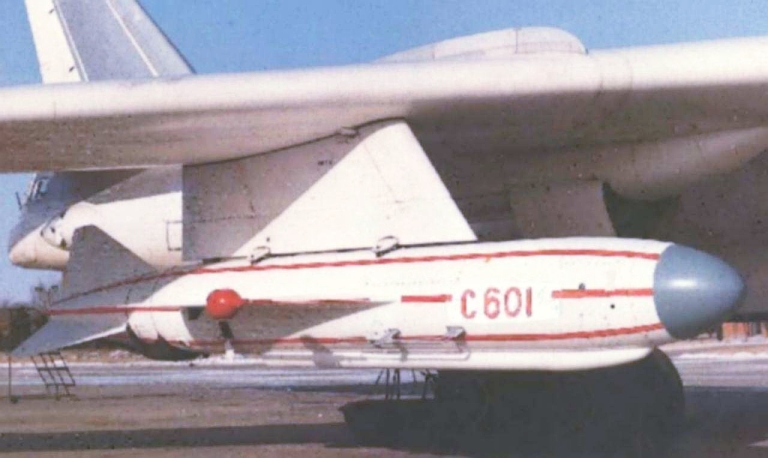
The Kh-22 is a formidable weapon by any measure, powered by an Isayev R-201-300 (S5.33) liquid rocket delivering 83 kN full thrust and 5.9 kN cruise thrust, it is claimed to exceed 4.6 Mach in cruise at 80,000 ft AGL. Around 3 tonnes of propellant and oxidiser are carried - the highly toxic fuel presents serious handling problems in fuelling up the missile (these Isayev liquid fuel engines ran with AK-20K oxidiser - 80% nitric acid, 20% N2O4 with fluorine or iodine additives and TG02 fuel - 50% xylidine and 50% triethylamine). Cited range varies between 145 NMI (270 km) and 300 NMI (550 km), subject to variant and launch speed/altitude. Russian sources claim the 900 kg shaped charge warhead will blow a 5 metre diameter hole, penetrating 12 metres deep, when impacting a large warship.
Seven variants have been reported to date, and a mid life upgrade for the APK-22 guidance package has also been recently reported. Nuclear armed variants included a TERCOM system to supplement the inertial unit. If China proceeds with the much speculated upon Backfire purchase, the Kh-22 is likely to be supplied as the basic weapon for the aircraft. The Backfire carries up to three rounds, although typical payloads are one or two, on BD-45K/F adaptors.


When the Raduga bureau designed the P-15/4K-40 Termit (SS-N-2 Styx) anti-ship missile during the late 1950s, little could they have imagined that it would remain in production a half century later. The original Styx was powered by an Isayev P-15 liquid rocket rated at 1.213-0.554 tonnes thrust, using toxic AK-20K/TG-02 propellant, armed with an 1,100 lb (513 kg) shaped charge warhead and fitted with a con-scan active radar seeker. The weapon's first kill was the Israeli warship Eilat in 1967.
Cloned Chinese Styxes entered production in 1974 as the HY-1/SY-1 or CSS-N-1 Silkworm coastal defence and shipborne ASM. The Chinese soon improved the design, the stretched 6,600 lb (3,000 kg) HY-2 (C-201) or CSS-N-2 Seersucker carrying more propellant and achieving a range of up to 73 NMI (135 km). Many derivative followed, including models with infrared homing seekers, television seekers, monopulse radar seekers and the turbojet powered HY-4. The air launched YJ-6/C-601 or CAS-1 Kraken entered production during the mid 1980s, based on the HY-2 variant, and is carried by naval H-6D Badgers. It was superceded in production by the YJ-61/C-611 with improved 110 NMI (200 km) range via higher energy propellant. Iran acquired several hundred HY-2s and used the missile extensively during the 'tanker war'. It is now claimed that Iran is manufacturing its own clones of the HY-2 and HY-4.
While the Silkworm/Seersucker is a subsonic sea skimmer, it sheer size adds significant lethality. While it is often not regarded to be a serious threat to surface warships, it has the killing power to be a very effective blockade weapon against civilian shipping and naval transports, or amphibious vessels. Iraq used the HY-2 as a land attack cruise missile prior to the fall of Saddam, five were launched and most were neither detected nor engaged by Patriot batteries due to their low level cruise profile over flat terrain. Papers by US analyst Dennis Gormley repeatedly note the ease with which the land mobile turbojet powered HY-4 could be stretched to provide a 380 NMI (700 km) class cruise missile, equipped with GPS/IMU accurate enough to present a genuine risk to coalition ground forces. With thousands of cloned Styx derivatives worldwide, this early Cold War relic may remain a viable weapon in coming decades.


Manticore
RETIRED MOD

- Joined
- Jan 18, 2009
- Messages
- 10,115
- Reaction score
- 114
- Country
- Location
The recently revealed KD-63 is a derivative of the air-breathing HY-4 Sadsack. While it retains the delta wing and fuselage shape of the HY-4, it uses a new cruciform tail design, and includes a television / datalink terminal guidance package. It is thus a dual role weapon, capable of precision strikes against land and maritime targets. It is carried by the newly designed H-6H Badger variant, replacing the pair of Krakens carried by earlier variants. Range is cited at around 100 nautical miles.


http://www.ausairpower.net/APA-PLA-Cruise-Missiles.html
China is known to have illegally acquired, in a joint operation with Iran, several examples of the Kh-55SM Kent cruise missile from storage in the Ukraine, including some ground equipment. The cost of the investment suggests an interest in partial or complete reverse engineering of this missile.
The Kh-55 family of cruise missiles owes its origins to a series of internal studies at the Raduga OKB during the early 1970s. Raduga were unsuccessful initially in convincing the Soviet leadership of the value of their concept, but this changed as public knowledge of the US AGM-86 Air Launched Cruise Missile program became better known in the Soviet Union.
Russian sources claim that Raduga's early work on these weapons was opposed by many Russian experts who were deeply sceptical of the viability of such a complex new weapon.
The Kh-55 family of weapons most closely resemble the early US BGM-109 Tomahawk in concept, using a cylindrical fuselage with pop out planar wings, unfolding tail control surfaces, and a ventral turbofan engine, with guidance provided by a TERrain COntour Matching (TERCOM) aided inertial navigation system.
The most visible difference between the Tomahawk and Kh-55 families of missiles is the engine installation. The Tomahawk's Williams F107-WR100 engine is embedded in the tail and uses a ventral inlet duct and tailcone exhaust. The Kh-55's Omsk AMKB TVD-50 two spool turbofan is mounted in a nacelle which is stowed in the aft fuselage and deploys via a ventral door on a pylon after launch.
The TVD-50 is a critical piece of technology in the Kh-55 as it is a compact and fuel efficient turbofan in the thrust and size class required to power cruise missiles, standoff missiles and UAVs. The cited thrust rating is 400 to 500 kp (880 to 1,000 lbf), with a dry mass of 95 kg (210 lb), a Specific Fuel Consumption of 0.65, a length of 0.85 m (33.5 in) and diameter of 0.33 m (13 in).
The Tomahawk uses a four surface tail control assembly with anhedral on the stabilators, whereas the Kh-55 uses only three larger surfaces, with more pronounced anhedral, a configuration since adopted in the new Block IV RGM/UGM-109E Tomahawk Land Attack Missile. The largely symmetrical aft fuselage of the Tomahawk differs from the more pronounced sculpting of the Kh-55 aft fuselage.
The cylindrical fuselage configuration is essentially the same for both designs. The Tomahawk has a 21 in diameter, the Kh-55 a 20.5 in diameter, the Tomahawk weighed 2,700 lb at launch, the Kh-55 2,870 lb. The later blocks of the Tomahawk have a chinned 'Beluga' nose to reduce radar signature, the Kh-55 retains an ogival/spherical nose.
The baseline guidance package on both missiles is designed around a digital computer running Kalman filter and TERCOM software, with an onboard memory storing a digital map, coupled to a radar altimeter for terrain profiling and a low drift inertial unit. Tomahawks later acquired an optical Digital Scene Matching Area Correlator and GPS - the Soviet had DSMAC technology but it has never been disclosed whether this was added to the Kh-55 series. The cited designation for the Kh-55 guidance package is the Sprut and BSU-55.
Like the Tomahawk, the Kh-55 spawned a range of derivatives, unlike the Tomahawk the Kh-55 became the dominant air launched weapon. The first generation of Kh-55s appeared in three configurations, entering service in 1984. The 'Izdeliye 120' Kh-55 / AS-15A was air launched from the Tu-95MS using a MKU-6-5 rotary launcher and external pylons, the RKV-500A / SS-N-21 Sampson was tube launched from the Type 671 Victor, Type 945 Sierra and Type 971 Akula submarines, and the RK-55 / SSC-X-4 Slingshot tube launched from a MAZ-543M (MAZ-7910) 8x8 TEL, carrying six rounds.
The air launched Kh-55 was followed by the improved 'Izdeliye 124' Kh-55OK, which was supplanted in production by the most capable 'Izdeliye 125' Kh-55SM / AS-15B subtype in 1987.
The aim of the Kh-55SM design was to further extend the striking range of the basic missile, cited at 1,350 NMI (2,500 km). This was achieved by adding a pair of conformal fuselage fuel tanks, which increased launch weight to 3,750 lb (1,700 kg), but increased cruise range to 1,620 NMI (3,000 km) with a 200 kT warhead fitted. The naval variant of the Kh-55SM was designated the RKV-500B.
A conventional derivative of the Kh-55, designated the Kh-555, was recently announced. A lightweight shorter ranging derivative weapon, the Kh-65, has been actively marketed since the 1990s.
For all intents and purposes, the late model Kh-55SM is a heavier and longer ranging equivalent to the BGM-109B Tomahawk, with performance closest to the AGM-86B ALCM.

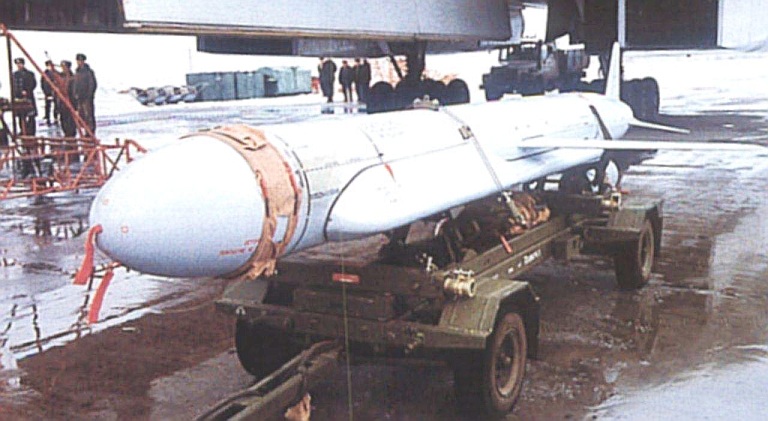


http://www.ausairpower.net/APA-PLA-Cruise-Missiles.html
China is known to have illegally acquired, in a joint operation with Iran, several examples of the Kh-55SM Kent cruise missile from storage in the Ukraine, including some ground equipment. The cost of the investment suggests an interest in partial or complete reverse engineering of this missile.
The Kh-55 family of cruise missiles owes its origins to a series of internal studies at the Raduga OKB during the early 1970s. Raduga were unsuccessful initially in convincing the Soviet leadership of the value of their concept, but this changed as public knowledge of the US AGM-86 Air Launched Cruise Missile program became better known in the Soviet Union.
Russian sources claim that Raduga's early work on these weapons was opposed by many Russian experts who were deeply sceptical of the viability of such a complex new weapon.
The Kh-55 family of weapons most closely resemble the early US BGM-109 Tomahawk in concept, using a cylindrical fuselage with pop out planar wings, unfolding tail control surfaces, and a ventral turbofan engine, with guidance provided by a TERrain COntour Matching (TERCOM) aided inertial navigation system.
The most visible difference between the Tomahawk and Kh-55 families of missiles is the engine installation. The Tomahawk's Williams F107-WR100 engine is embedded in the tail and uses a ventral inlet duct and tailcone exhaust. The Kh-55's Omsk AMKB TVD-50 two spool turbofan is mounted in a nacelle which is stowed in the aft fuselage and deploys via a ventral door on a pylon after launch.
The TVD-50 is a critical piece of technology in the Kh-55 as it is a compact and fuel efficient turbofan in the thrust and size class required to power cruise missiles, standoff missiles and UAVs. The cited thrust rating is 400 to 500 kp (880 to 1,000 lbf), with a dry mass of 95 kg (210 lb), a Specific Fuel Consumption of 0.65, a length of 0.85 m (33.5 in) and diameter of 0.33 m (13 in).
The Tomahawk uses a four surface tail control assembly with anhedral on the stabilators, whereas the Kh-55 uses only three larger surfaces, with more pronounced anhedral, a configuration since adopted in the new Block IV RGM/UGM-109E Tomahawk Land Attack Missile. The largely symmetrical aft fuselage of the Tomahawk differs from the more pronounced sculpting of the Kh-55 aft fuselage.
The cylindrical fuselage configuration is essentially the same for both designs. The Tomahawk has a 21 in diameter, the Kh-55 a 20.5 in diameter, the Tomahawk weighed 2,700 lb at launch, the Kh-55 2,870 lb. The later blocks of the Tomahawk have a chinned 'Beluga' nose to reduce radar signature, the Kh-55 retains an ogival/spherical nose.
The baseline guidance package on both missiles is designed around a digital computer running Kalman filter and TERCOM software, with an onboard memory storing a digital map, coupled to a radar altimeter for terrain profiling and a low drift inertial unit. Tomahawks later acquired an optical Digital Scene Matching Area Correlator and GPS - the Soviet had DSMAC technology but it has never been disclosed whether this was added to the Kh-55 series. The cited designation for the Kh-55 guidance package is the Sprut and BSU-55.
Like the Tomahawk, the Kh-55 spawned a range of derivatives, unlike the Tomahawk the Kh-55 became the dominant air launched weapon. The first generation of Kh-55s appeared in three configurations, entering service in 1984. The 'Izdeliye 120' Kh-55 / AS-15A was air launched from the Tu-95MS using a MKU-6-5 rotary launcher and external pylons, the RKV-500A / SS-N-21 Sampson was tube launched from the Type 671 Victor, Type 945 Sierra and Type 971 Akula submarines, and the RK-55 / SSC-X-4 Slingshot tube launched from a MAZ-543M (MAZ-7910) 8x8 TEL, carrying six rounds.
The air launched Kh-55 was followed by the improved 'Izdeliye 124' Kh-55OK, which was supplanted in production by the most capable 'Izdeliye 125' Kh-55SM / AS-15B subtype in 1987.
The aim of the Kh-55SM design was to further extend the striking range of the basic missile, cited at 1,350 NMI (2,500 km). This was achieved by adding a pair of conformal fuselage fuel tanks, which increased launch weight to 3,750 lb (1,700 kg), but increased cruise range to 1,620 NMI (3,000 km) with a 200 kT warhead fitted. The naval variant of the Kh-55SM was designated the RKV-500B.
A conventional derivative of the Kh-55, designated the Kh-555, was recently announced. A lightweight shorter ranging derivative weapon, the Kh-65, has been actively marketed since the 1990s.
For all intents and purposes, the late model Kh-55SM is a heavier and longer ranging equivalent to the BGM-109B Tomahawk, with performance closest to the AGM-86B ALCM.


Manticore
RETIRED MOD

- Joined
- Jan 18, 2009
- Messages
- 10,115
- Reaction score
- 114
- Country
- Location
Launch of a 'Tomahawk-like' PLA-N YJ-62/C-602 cruise missile .
The YJ-62 cruise missile is a PLAN analogue to the anti-shipping variants of the RGM-109 Tomahawk/MRASM. The weapon has a similar general configuration to the Tomahawk family, but employs a unique fixed scoop inlet for the air breathing engine.
Claims for this weapon include an active radar homing seeker with a monopulse antenna, GPS/Glonass/inertial midcourse guidance, alternate turbojet and turbofan engines, and ship, sub, coastal battery and air launch configurations.
Cited specifications include a length of 6.1/7.0 metres, launch mass of 1,140/1,350 kg, warhead mass of 300 kg, cruise speed of 0.9 Mach, range for turbojet variant of 280 km / 150 NMI, and dual mode anti-ship and coastal target capability similar to later blocks of the Harpoon.
The YJ-62 is claimed to have been deployed on the Type 052C Luyang II destroyer.

The C-701 and C-704 missiles are analogues to the French Exocet family of missiles, available with a range of active radar and electro-optical terminal seekers.
C-704KD Electro-Optical variants with gimballed TV and IIR seekers, at Zhuhai 2008. The IIR version uses a Magnesium Fluoride window (images © 2009, Zhenguan Studio).
C-701 anti-ship cruise missile with active radar seeker displayed at Zhuhai 2008 (image © 2009, Zhenguan Studio).
The C-705 is a planar wing derivative of the C-701/704 family of weapons. It was first displayed at Zhuhai 2008 (image © 2009, Zhenguan Studio).


The YJ-62 cruise missile is a PLAN analogue to the anti-shipping variants of the RGM-109 Tomahawk/MRASM. The weapon has a similar general configuration to the Tomahawk family, but employs a unique fixed scoop inlet for the air breathing engine.
Claims for this weapon include an active radar homing seeker with a monopulse antenna, GPS/Glonass/inertial midcourse guidance, alternate turbojet and turbofan engines, and ship, sub, coastal battery and air launch configurations.
Cited specifications include a length of 6.1/7.0 metres, launch mass of 1,140/1,350 kg, warhead mass of 300 kg, cruise speed of 0.9 Mach, range for turbojet variant of 280 km / 150 NMI, and dual mode anti-ship and coastal target capability similar to later blocks of the Harpoon.
The YJ-62 is claimed to have been deployed on the Type 052C Luyang II destroyer.

The C-701 and C-704 missiles are analogues to the French Exocet family of missiles, available with a range of active radar and electro-optical terminal seekers.
C-704KD Electro-Optical variants with gimballed TV and IIR seekers, at Zhuhai 2008. The IIR version uses a Magnesium Fluoride window (images © 2009, Zhenguan Studio).
C-701 anti-ship cruise missile with active radar seeker displayed at Zhuhai 2008 (image © 2009, Zhenguan Studio).
The C-705 is a planar wing derivative of the C-701/704 family of weapons. It was first displayed at Zhuhai 2008 (image © 2009, Zhenguan Studio).


Manticore
RETIRED MOD

- Joined
- Jan 18, 2009
- Messages
- 10,115
- Reaction score
- 114
- Country
- Location
YJ-82/C-802A cruise missile at Zhuhai 2008 (image © 2009, Zhenguan Studio).
China's indigenous response to the Exocet and Harpoon lies in the YJ-8 (CSS-N-4 Sardine) family of missiles, available in ship, sub, land and air launch variants. The basic air launch rocket powered YJ-8K achieves 27 NMI (50 km) range, the improved YJ-81 cca 43 NMI (80 km), the turbojet YJ-82 (CSS-N-8 Saccade) cca 65 NMI (120 km), and the recently trialed YJ-83 variant around 135 NMI (250 km). These are the primary weapon of many PLA-N warships, and the FH-7 maritime fighter carrying four rounds.
http://www.ausairpower.net/APA-PLA-Cruise-Missiles.html
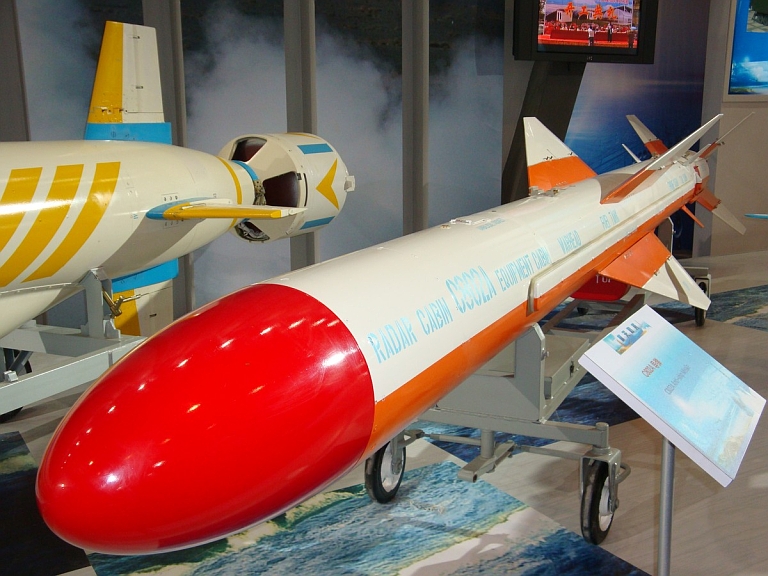
The Molniya Kh-29 / AS-14 Kedge is a Russian supersonic equivalent to the French AS.30 and US AGM-65 Maverick, and is primarily intended for interdiction and close air support, and maritime strike roles. An APU-58 or AKU-58 launcher is used, on the Su-27/30 Flanker (up to 6 rounds), the MiG-27 Flogger (2 rounds), Su-17/22 Fitter (2 rounds) and Su-24M Fencer (3 round). Multiple variants exist.
The Kh-28L (Izdeliye 63 or AS-14A) is a semi-active laser homing variant used in the manner of the AS.30L, with a 24N1 seeker. The Kh-29T (Izdeliye 64 or AS-14B) is an electro-optical variant with a TV datalink and command uplink, using the APK-9 Tekon pod. The Kh-29TE is an enhanced variant. The Kh-29D is another EO variant, equipped with a thermal imaging seeker.
Launch weight for most variants is around 1,500 lb, with a 700 lb warhead being used most often. Range is usually cited at 16 nautical miles for a high altitude launch.
Kh-29TE (left) and APK-9E datalink pod (centre).
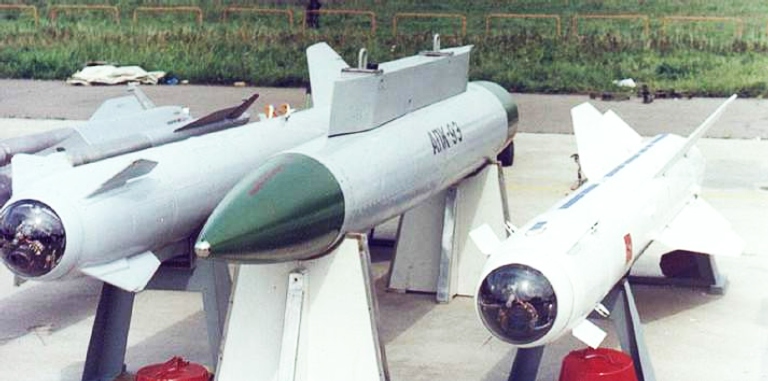
http://www.ausairpower.net/APA-Regional-PGM.html
Kh-29L (foreground) and Kh-29TE (background).
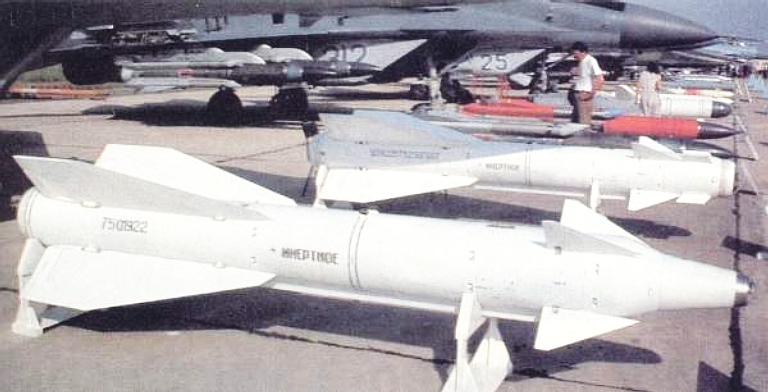
China's indigenous response to the Exocet and Harpoon lies in the YJ-8 (CSS-N-4 Sardine) family of missiles, available in ship, sub, land and air launch variants. The basic air launch rocket powered YJ-8K achieves 27 NMI (50 km) range, the improved YJ-81 cca 43 NMI (80 km), the turbojet YJ-82 (CSS-N-8 Saccade) cca 65 NMI (120 km), and the recently trialed YJ-83 variant around 135 NMI (250 km). These are the primary weapon of many PLA-N warships, and the FH-7 maritime fighter carrying four rounds.
http://www.ausairpower.net/APA-PLA-Cruise-Missiles.html

The Molniya Kh-29 / AS-14 Kedge is a Russian supersonic equivalent to the French AS.30 and US AGM-65 Maverick, and is primarily intended for interdiction and close air support, and maritime strike roles. An APU-58 or AKU-58 launcher is used, on the Su-27/30 Flanker (up to 6 rounds), the MiG-27 Flogger (2 rounds), Su-17/22 Fitter (2 rounds) and Su-24M Fencer (3 round). Multiple variants exist.
The Kh-28L (Izdeliye 63 or AS-14A) is a semi-active laser homing variant used in the manner of the AS.30L, with a 24N1 seeker. The Kh-29T (Izdeliye 64 or AS-14B) is an electro-optical variant with a TV datalink and command uplink, using the APK-9 Tekon pod. The Kh-29TE is an enhanced variant. The Kh-29D is another EO variant, equipped with a thermal imaging seeker.
Launch weight for most variants is around 1,500 lb, with a 700 lb warhead being used most often. Range is usually cited at 16 nautical miles for a high altitude launch.
Kh-29TE (left) and APK-9E datalink pod (centre).

http://www.ausairpower.net/APA-Regional-PGM.html
Kh-29L (foreground) and Kh-29TE (background).

Manticore
RETIRED MOD

- Joined
- Jan 18, 2009
- Messages
- 10,115
- Reaction score
- 114
- Country
- Location
The Mach 4.5 ramjet Kh-31P/MP/A/MA Krypton family of missiles includes anti-radiation, anti-shipping and anti-AWACS variants. Reports claim the PRC intends to licence build this weapon, depicted an Su-30KN prototype (KNAAPO).
Dubbed the 'Mini-Moskit', the supersonic Turayev ramjet powered Kh-31P (AS-17 Krypton) was originally designed as an anti-radiation missile to suppress NATO Patriot and IHawk batteries, entering use in 1988, with an L-111E family interferometric seeker. Since the end of the Cold War it has evolved an extended range airframe (Kh-31MP / Type 2 - 100+ NMI range). An anti-ship variant equipped with an active radar seeker, the Kh-31A/MA, was recently introduced, adaptation of this seeker permitting counter-ISR roles as an AWACS-Killer. At altitude the Kh-31 achieves Mach 4.5, as sea level Mach 2.7. Su-30MK fitted for the Kh-31 series carry up to six rounds on wing stations 3, 4, 11, 12 and inlet stations 9 and 10, using AKU-58 adaptors, the Su-27SKU four rounds on 3, 4, 9 and 10.
It has no equivalent in the Western inventory, the US Navy using it as the MA-31 target drone. The PLA is reported to use this weapon with recent claims of plans for licence production.


The 2,000 lb (920 kg) 62 NMI (115 km) range Kh-59M/D (AS-18 Kazoo) series stand-off weapon is a direct equivalent to the AGM-142 missile now being integrated on the RAAF's F-111C. Evolved from an anti-radiation missile, it shares the common Granit 7TM1 optical seeker and Raduga APK-9 Tekon DL pod with the KAB series, the D-model fitted with a thermal imager, and uses an RDK-300 jet sustainer. The PLA-N is reported to have ordered an anti-ship variant equipped with a radar seeker, designated the Kh-59MK2, for the Su-30MK2.
Su-27SK/30MK fitted for the Kh-59M/MK2 carry two rounds on wing stations 3 and 4, using AKU-58 adaptors, the pod carried on inlet station 9.

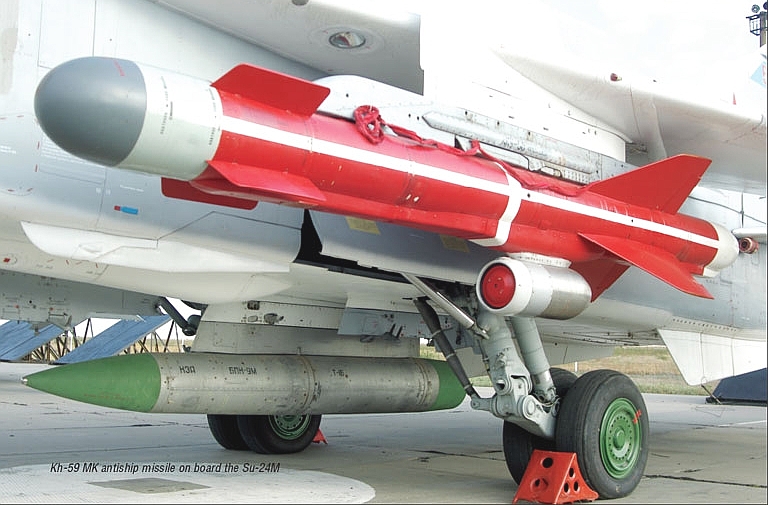
Dubbed the Kharpunski the Kh-35U Uran (AS-20 Kayak/SS-N-25 Switchblade) is the Russian equivalent to the US RGM-84/AGM-84 Harpoon. The missile is available in surface launched and air launched versions (AKU-58 adaptor) and was publicly canvassed as an option for India's Tu-142 Bear upgrade - it is already deployed on the New Delhi class DDG, reports indicate China ordered in 2001. An ARGS-35 active radar seeker is used, and there are claims of a 'SLAM-like' land attack variant although no images are as yet available.

Dubbed the 'Mini-Moskit', the supersonic Turayev ramjet powered Kh-31P (AS-17 Krypton) was originally designed as an anti-radiation missile to suppress NATO Patriot and IHawk batteries, entering use in 1988, with an L-111E family interferometric seeker. Since the end of the Cold War it has evolved an extended range airframe (Kh-31MP / Type 2 - 100+ NMI range). An anti-ship variant equipped with an active radar seeker, the Kh-31A/MA, was recently introduced, adaptation of this seeker permitting counter-ISR roles as an AWACS-Killer. At altitude the Kh-31 achieves Mach 4.5, as sea level Mach 2.7. Su-30MK fitted for the Kh-31 series carry up to six rounds on wing stations 3, 4, 11, 12 and inlet stations 9 and 10, using AKU-58 adaptors, the Su-27SKU four rounds on 3, 4, 9 and 10.
It has no equivalent in the Western inventory, the US Navy using it as the MA-31 target drone. The PLA is reported to use this weapon with recent claims of plans for licence production.


The 2,000 lb (920 kg) 62 NMI (115 km) range Kh-59M/D (AS-18 Kazoo) series stand-off weapon is a direct equivalent to the AGM-142 missile now being integrated on the RAAF's F-111C. Evolved from an anti-radiation missile, it shares the common Granit 7TM1 optical seeker and Raduga APK-9 Tekon DL pod with the KAB series, the D-model fitted with a thermal imager, and uses an RDK-300 jet sustainer. The PLA-N is reported to have ordered an anti-ship variant equipped with a radar seeker, designated the Kh-59MK2, for the Su-30MK2.
Su-27SK/30MK fitted for the Kh-59M/MK2 carry two rounds on wing stations 3 and 4, using AKU-58 adaptors, the pod carried on inlet station 9.


Dubbed the Kharpunski the Kh-35U Uran (AS-20 Kayak/SS-N-25 Switchblade) is the Russian equivalent to the US RGM-84/AGM-84 Harpoon. The missile is available in surface launched and air launched versions (AKU-58 adaptor) and was publicly canvassed as an option for India's Tu-142 Bear upgrade - it is already deployed on the New Delhi class DDG, reports indicate China ordered in 2001. An ARGS-35 active radar seeker is used, and there are claims of a 'SLAM-like' land attack variant although no images are as yet available.

Cool_Soldier
FULL MEMBER

- Joined
- Jun 27, 2011
- Messages
- 1,745
- Reaction score
- 0
- Country
- Location
Nice information.
Similar threads
- Replies
- 9
- Views
- 2K
- Replies
- 1
- Views
- 1K
- Replies
- 43
- Views
- 5K
- Replies
- 56
- Views
- 7K
- Replies
- 0
- Views
- 704
Latest posts
-
India launches missile attacks on Multiple locations in Pakistan,
- Latest: RaktimChandra
-
-
-
Why Pakistan’s JF-17 Thunder Is Outshining India’s Tejas on the World Stage
- Latest: FourMikeEcho
-








